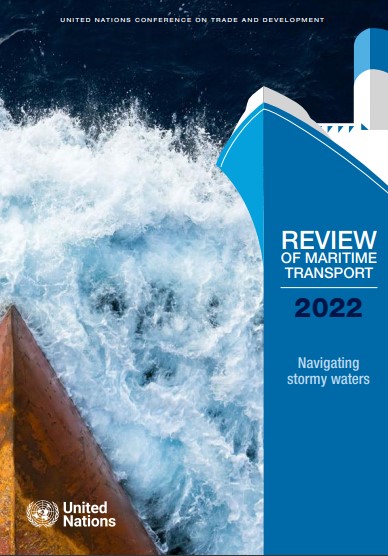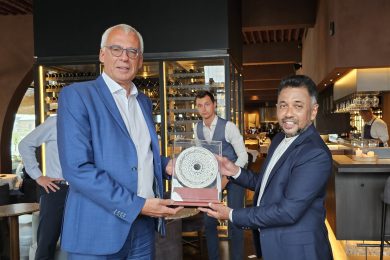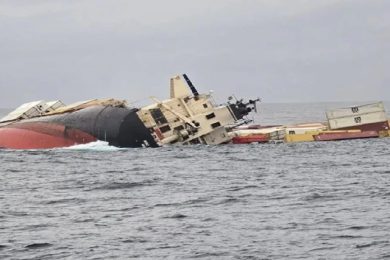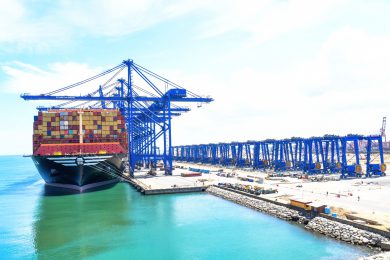Why should all industry stakeholders study the Review of Maritime Transports, a key recurrent publication prepared by the UNCTAD secretariat since 1968?
by Nilantha Ilangamuwa
“We provide a neutral unbiased assessment of trends, challenges and opportunities,” Dr Jan Hoffmann who is the Chief of Trade Logistics Branch, Division on Technology and Logistics at the United Nations Conference on Trade and Development (UNCTAD) said in an interview with news.slpa.lk, an exclusive maritime news and views portal run by the Communication and Public Relations Division of Sri Lanka Ports Authority. The interview mainly focused on the just released, annual UNCTAD Review of Maritime Transport, co-authored by Dr Hoffmann.
Previously, Jan spent six years with the United Nations Economic Commission for Latin America and the Caribbean (ECLAC) in Santiago de Chile, and two years with the International Maritime Organization (IMO) in London and Santiago. Studied in Germany, United Kingdom, and Spain, Dr. Hoffmann holds a doctorate degree in Economics from the University of Hamburg.
Excerpts of the interview;
Question (Q): The world is slowly but steadily overcoming the challenges of the pandemic. But the consequences are still disrupting the global supply chain. Do you see any difference in consequences on Global Supply Chain by this pandemic from what human civilization faced previously?
Answer (A): What was new and different in this crisis, compared to earlier crises which were more about financial and economic growth issues, is that we had a problem on the supply side. Intermodal transport networks were clocked up, ships spent 20% longer in port than pre-covid, and processes that were not paperless slowed down due to the need for social distancing. In that sense, I’d say we had a unique, new type of crisis.
On the positive side, as your question also points to “consequences” and thus the future, we have seen many reforms in digitalization and investment in more agile and paperless procedures.
Now, for the future, I hope that we can “lock in the progress made during lockdown” as regards this modernization achieved in response to the pandemic.
Q: Global population hits all-time higher, 8 billion, last week. This big number is telling us the need for more resilience Global Supply Chains. Tell us the importance of collective responsibility and inclusiveness between ports, shipping lines, and regulatory bodies.
A: Without shipping, the world could not feed 8 billion people, nor provide the necessary fuel and medicine for all of us. While the population grew, seaborne trade grew even faster, reaching 11 billion tons. That’s almost 1.4 tons of cargo per year for each one of us, and twice as much as 50 years ago, when it was about 0.7 tons per person.
As much as ports and shipping are important for our trade, there is a responsibility for humanity for future generations. We need to ensure that those of us who benefit from the maritime transport services today, ultimately also pay for the negative externalities, notably pollution and green-house-gas emissions. We need a mechanism where a price on pollution and emissions can be used to pay for investments in the energy transition, and also to compensate and help those most vulnerable countries that were not the culprits of climate change. Many of these most vulnerable countries may now also be most negatively affected by climate change, and by measures to mitigate climate change.
Let me clarify this latter point: If we reduce emissions from shipping, the costs of shipping will go up a little bit (less than the costs of inaction), but these additional maritime transport costs will be particularly bad for small island developing States and other vulnerable economies. So, we need to help them find other ways to reduce their transport and trade costs, in addition to helping them adapt to climate change.
Q: All sets to launch this year, Review of Maritime Transports, a key recurrent publication prepared by the UNCTAD secretariat since 1968. Why should all industry stakeholders study this review?
A: We are effectively very proud of this publication. We write it ourselves, i.e. UNCTAD staff and not external consultants. We provide a neutral unbiased assessment of trends, challenges and opportunities.
I would also like to highlight that our Review is part of a broader “package”, which includes regularly updated statistics (http://stats.unctad.org/maritime) as well as 230 country profiles, where you can look up key data and trends for every economy of the world. See for example the maritime country profile for Sri Lanka here: https://unctadstat.unctad.org/CountryProfile/MaritimeProfile/en-GB/144/index.html
Q: How do you get real-time data and what are the challenges you faced?
A: We benefit from a wide range of partnerships with data providers, who are all duly acknowledged and sourced in the Review.

We do face challenges of obtaining reliable data from member countries. This process is slow and not always reliable.
But we are lucky that every ship in the world has a unique number – a so-called IMO number – and must continuously report its position. Thus, by looking at data about individual ships, we can see where they are built, owned, registered (i.e. their flag), their journeys and port calls. Combining this information with other data sets about prices, trade and freight costs, we have an increasingly comprehensive and reliable picture about the “supply chain” of maritime transport, from building to scrapping, and the participation of different countries in this supply chain.
Q: Beginning of the report is giving us a kind of frightening statement; “maritime trade recovered in 2021, but in 2022 faces a complex operating environment fraught with risk and uncertainty.” Does it mean there is no light at end of the tunnel? What are you suggesting to overcome this uncertainty and mitigate the risk?
A: In fact, the brunt of the covid-induced supply chain crisis is largely over. Container freight rates are going down. But then we also have the war in Ukraine, which had led to a surge in grain transport costs earlier this year, which is now softened thanks to the Grain Initiative. For the transport of oil and gas, however, shipping costs are now surging, because more cargo has to be carried over longer distances.
And all this is but a precursor to the medium- and long-term challenge of decarbonizing shipping. Here, we do not know what will be the future energy mix for shipping, what will be the price of GHG emissions, and what will be the global regulations. We do highlight the need for a predictable multilateral framework, so as to avoid that investors delay investments in ports, ships, and energy distribution. Such delays could lead to future shortages of maritime transport supply capacity. Such a shortage – we have seen during the 2020-22 supply chain crisis – can lead to very high surges in shipping costs.
Investments in resilient and sustainable maritime transport systems take time. We need forward-looking investments in reforms and infrastructure from the public sector, and the private sector needs to know under what conditions and prices and regulations port and shipping services will be provided in the future.
Q: The report revealed that “between 2020 and 2021, total emissions from the world fleet increased by 4.7 per cent, with most of the increases coming from container ships, dry bulk and general cargo vessels.” This is alarming. What would you recommend to stakeholders and other relevant parties?
A: The increase of emissions has been less than the increase in the fleet. So, on a positive side, we also report that efficiency has improved, i.e. we have fewer emissions per ton-mile. But then there is another “but”: An important part of this improvement is not due to real technological progress, but rather due to economies of scale and lower speeds. There are some really interesting novel data charts in the report in Chapter 4.
As regards global initiatives towards reductions of emissions, these are led by the IMO – the International Maritime Organization. We at UNCTAD work closely with the IMO in support of this endeavor. For example, we have undertaken a comprehensive impact assessment of what specific short-term measures to reduce green-house-gas emissions would mean for trade costs, trade, and economic development. This assessment helped the IMO membership to advance with decisions in this direction.
Progress is being made also on specific green corridors, and some “first movers” area advancing with investments in ships running on different alternative fuels.
Some stakeholders are – in my view – still too reluctant to take the necessary steps toward more ambitious goals at the IMO. They are afraid of the additional maritime transport costs this might imply. Now, if we see how a shortage of maritime transport supply capacity during the recent supply chain crisis led to significantly higher freight costs, I believe we need to avoid that investments in new port and shipping capacity is delayd. Put differently, the costs of inaction can be higher than the costs of the measures that we need to take to reduce emissions from shipping.
Featured Photo: Dr Jan Hoffmann who is the Chief of Trade Logistics Branch, Division on Technology and Logistics at the United Nations Conference on Trade and Development (UNCTAD)
[ Nilantha Ilangamuwa, Senior Manager, Communication and Public Relations Division of Sri Lanka Ports Authority]























